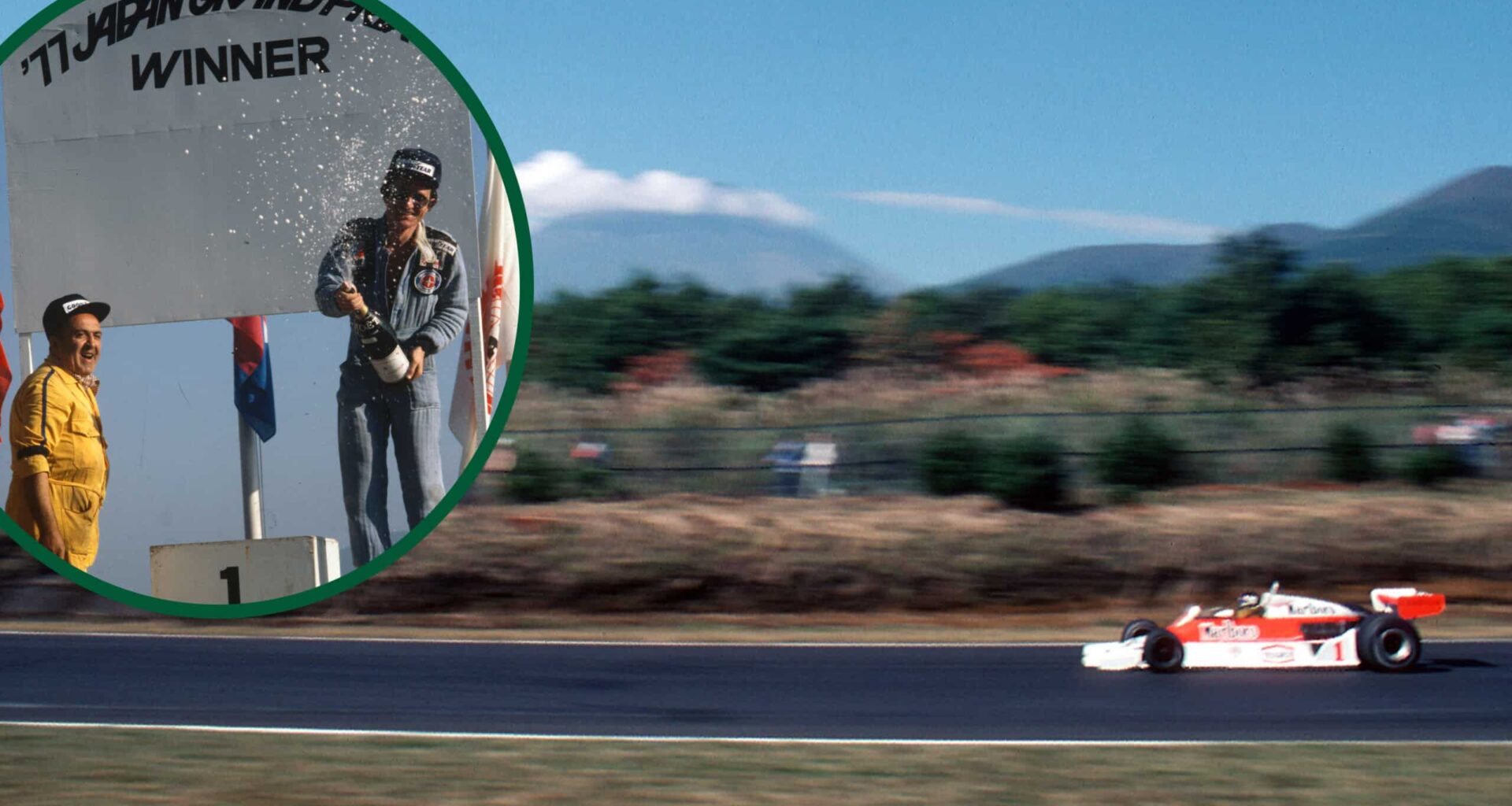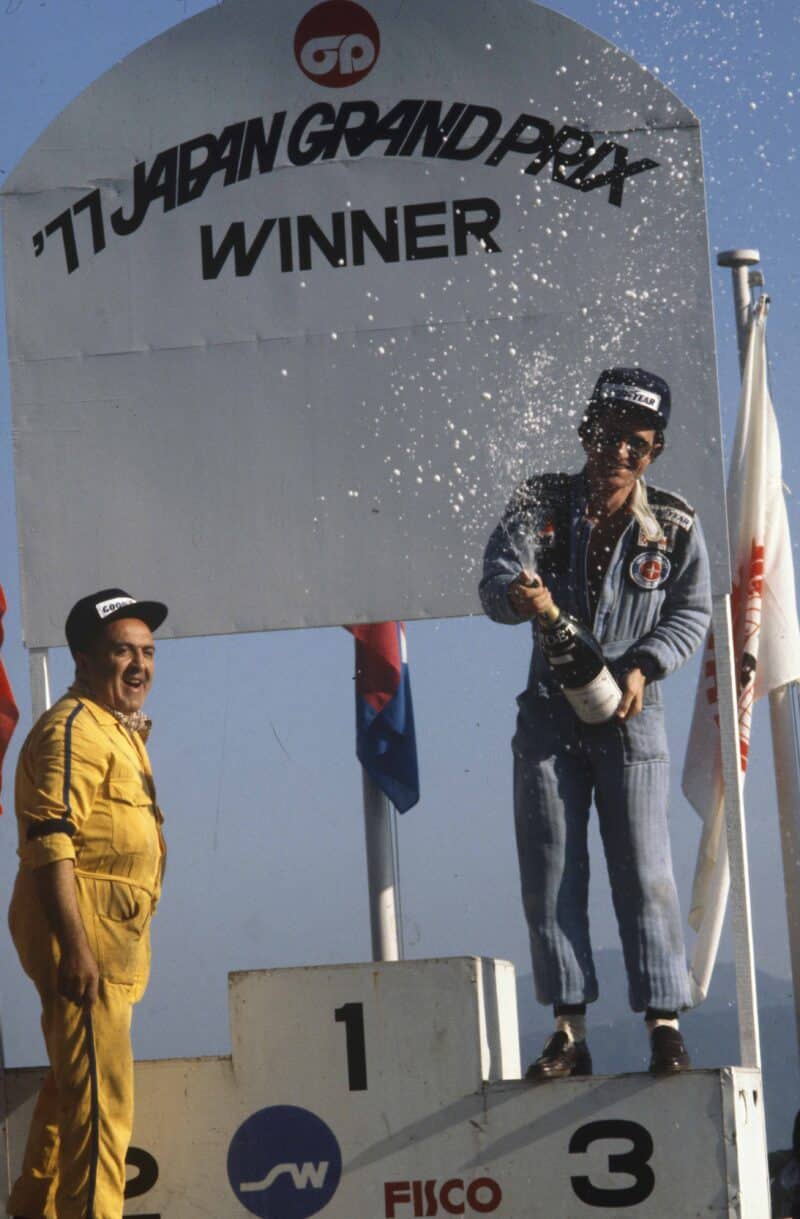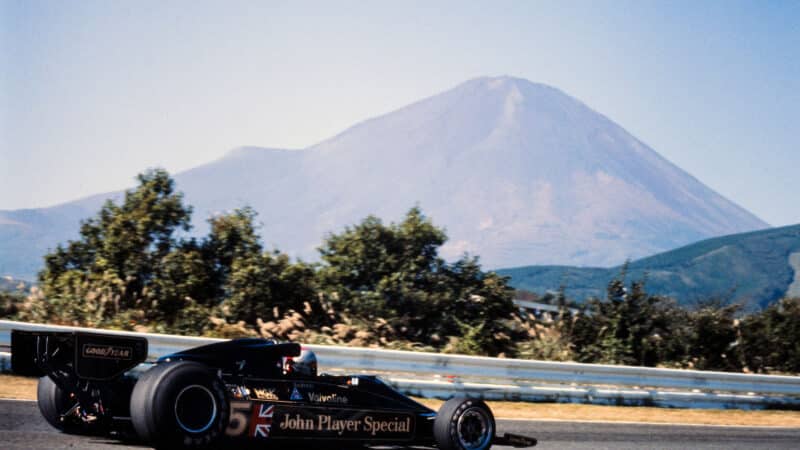The contrast is ridiculous – almost comically so. A Formula 1 post-race ceremony is nowadays a ritualised bacchanalia of exhibitionism and marketing: booming anthems, confetti cannons, Champagne choreography, celeb interviews, camera cranes swooping like vultures, sponsor logos everywhere, and the dutiful trudge to the cool-down room where the victors sip mineral water with passive-aggressive civility.
But cast your mind back, if you will, to the 1977 Japanese Grand Prix – at Fuji Speedway, on October 23, almost exactly 48 years ago therefore – and consider just how different were the festivities, if we can even call them that. The race was won by McLaren’s James Hunt — who once said he liked racing, girls, and having a good time, but not necessarily in that order — who avoided the podium entirely. Second place was claimed by Carlos Reutemann, that mysterious tango of polish and melancholy, who likewise vanished while his Ferrari’s flat-12 engine was still white-hot. Both men — winner and runner-up — skipped the post-race celebrations entirely, disappearing into the thin, crisp, mountainous air, chasing flights to Malaga and Nice respectively.
What we got instead — what, with a mixture of confusion and amusement, the watching world saw on the Fuji podium — was the lonely figure of the third-placed finisher, Tyrrell’s Patrick Depailler, wearing frayed overalls, baseball cap, street loafers, and shades, soothed by a ciggie already on the go, looking more like a plumber waiting at a bus stop than a sportsman saluting glory, still less a daring lead-foot who had just raced a six-wheeled F1 car quite brilliantly.
Two spaces along from Depailler, the other side of the vacant P1 plinth, stood — wait for it — Vittorugo Tramonti, a Magneti Marelli mechanic known to his mates as Scintilla (Italian for ‘spark’) who had been summoned, as if by raffle, to part-fill the gaping void created by the two absent superstars. Leaving the winner’s spot unoccupied, he grinned sheepishly from where Reutemann should have been standing. It was a moment of such Dadaist incongruity, such perfect F1 absurdity, that one might think it had been scripted by Federico Fellini.
Tramonti and Depailler made for an unlikely duo on the Fuji podium
LAT
Besides the whimsy of that post-race farce, the 1977 Japanese Grand Prix was not an event to be remembered lightly. It was a race haunted by surprises and anomalies – comical, yes, but also catastrophic – and its dramas were played out against the savage backdrop of the original and not yet molested Fuji Speedway. That stark seven-turn circuit, almost half of whose 2.709 miles (4.359km) of volcanically abrasive asphalt consisted of a frighteningly long straight preceded by a scarily fast corner, carved into the foothills of Japan’s most famous stratovolcano, was a formidable blur of speed and danger, a racetrack that rewarded bravura as generously as finesse. Despite two tight hairpins, Turn 1 and Turn 5, its overall lap speed was as high as the 1977 version of Silverstone and higher than the 1977 versions of Hockenheim and Monza.
Hunt’s victory, his tenth and last world championship-status F1 hurrah – in addition to which he had also won four non-championship F1 races – was, on paper at least, a clinical affair, thanks in no small part to the cack-handed munificence of Mario Andretti. The 37-year-old American, having secured pole position in his svelte Lotus 78 – a so-called wing-car that Brabham’s chief designer Gordon Murray had described as “black and gold magic” – fumbled his start, dropped down to 10th place, overtook Riccardo Patrese’s Shadow and Vittorio Brambilla’s Surtees on lap one, then shunted heavily on lap two while trying to pass Jacques Laffite’s Ligier on the approach to Turn 2, a flat-out left flick, triggering a further accident involving Hans Binder’s Surtees and Noritake Takahara’s Kojima.
Polesitter Andretti’s race was short-lived
David Phipps / Sutton Images
After that, Hunt’s path was clear. Never one to turn down a gift from Andretti, for whom he had been developing an increasingly splenetic disregard throughout the second half of the 1977 F1 season, especially when it had arrived so neatly wrapped, Hunt now swiftly and neatly drove away from the rest of the field, his McLaren running like a metronome.
He won easily, finishing more than a minute ahead of everyone else, and after the race he pulled his McLaren to a stop in parc fermé, jumped out of it, grabbed a few puffs on one of his favourite sponsor’s products, and changed into a double-denim going-away outfit without seeking privacy so to do, as though winning a grand prix were a matter of routine – perhaps even faintly dull. From there he bolted for the airport, jogging past the podium but neither stopping nor even slowing for it, mustard-keen as he was to hurry home to his Spanish lair, his beloved Alsatian, and the familiar comforts of nearby golf and tennis, willing women, and cheap Rioja. His final F1 grand prix win had therefore been untroubled by either joy or sentimentality – a curtain call performed efficiently by a man who, as he crossed the finish-line, immediately redirected his focus on how best to beat the motorway traffic between Fuji Speedway and Tokyo Haneda Airport.
However, even as Hunt had been cruising to victory, elsewhere the race had been spiralling into something darker. The collision between Gilles Villeneuve and Ronnie Peterson – two men who, between them, encapsulated the grace and fury of F1 in the 1970s – was an ugly knot in the tapestry. The 27-year-old Villeneuve, in only his second start for Ferrari and only his third in F1, was as brave as he was raw, and on the approach to Turn 1 on lap six his brake pedal went to the floor – the very worst feeling for a racing driver faced with a tight hairpin and now having no way of slowing for it. As he attempted to avoid the car ahead, Peterson’s six-wheeled Tyrrell, the two cars touched. Villeneuve’s Ferrari cartwheeled high into the air, its flightpath cut short by heavy impact with a marshal and eight spectators, the former in the act of ushering the latter out of an area in which for safety reasons members of the public were not permitted to stand. The marshal was killed, as was one of the spectators, and the other seven were all injured. Astonishingly, Villeneuve was unhurt.
Peterson inadvertently launched Villeneuve’s Ferrari into the air, with tragic consequences
LAT
The bitterest irony of that most grisly of racing calamities was that, a year earlier, the 1976 Japanese Grand Prix, the first ever F1 race at Fuji, had been held in monsoon conditions so treacherous that Larry Perkins (Brabham) on lap two, Niki Lauda (Ferrari) on lap three, Carlos Pace (Brabham) on lap eight, and Emerson Fittipaldi (Copersucar) on lap 10 had all driven their cars into their pit garages, parked them, and climbed out of them, citing the mortal danger of racing in a rainstorm that had reduced both grip and visibility to almost zero. Yet, even though that famous race then raged on throughout all its scheduled 73 laps, no-one had died. But in 1977, under clear blue skies, bathed in warm sunshine, and on dry asphalt, death had found a way in.
If that tragedy were not enough to cast a pall over the weekend – and nowadays, when fatalities are much rarer in F1, thank god, it would be – other elegies were writing themselves quietly in the margins. Gunnar Nilsson, the gifted and chummy Swede who had won the Belgian Grand Prix for Lotus earlier that year, was racing for the last time, in a Lotus 78 like that of his team-mate Andretti, but not one that anyone would describe as “black and gold magic”, for it had been painted in the bright red of Imperial Tobacco, the parent company of the John Player Special brand in whose famous black and gold livery Lotus F1 cars were resplendent from 1972 to 1986. Nilsson would be dead within a year, not from a crash but from a cruel and creeping cancer that would end his life at just 29.




